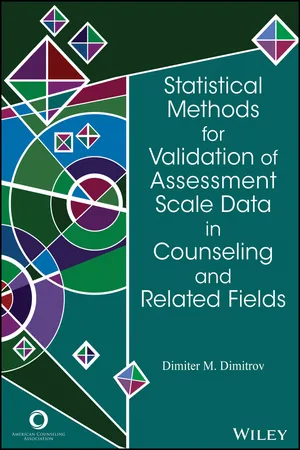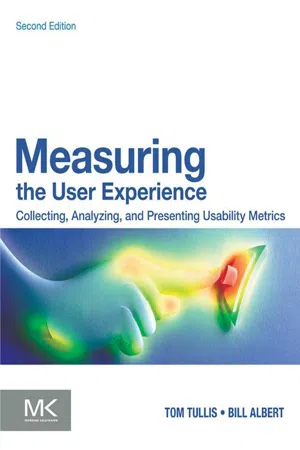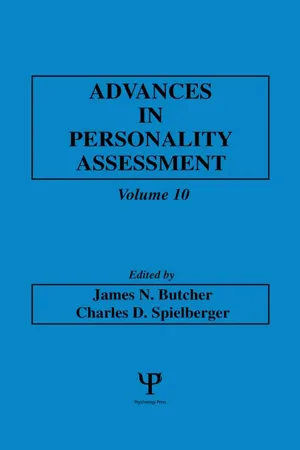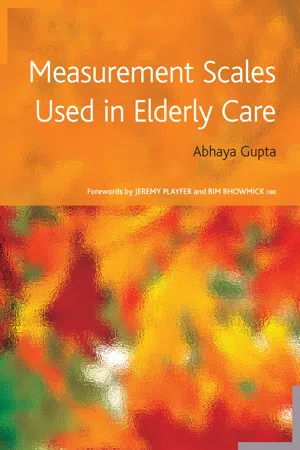Psychology
Self Report Scales
Self-report scales are assessment tools used to gather information directly from individuals about their thoughts, feelings, and behaviors. These scales typically consist of questionnaires or surveys that ask respondents to rate or describe their experiences. They are commonly used in psychological research and clinical practice to measure various constructs such as personality traits, mental health symptoms, and attitudes.
Written by Perlego with AI-assistance
Related key terms
6 Key excerpts on "Self Report Scales"
- eBook - ePub
- Dimiter M. Dimitrov(Author)
- 2014(Publication Date)
- American Counseling Association(Publisher)
strongly agree in five-level Likert items). Briefly described here are scales typically used for assessment in counseling, such as binary scales, Likert scales, Likert-type scales, and other rating scales.1.4.1 Binary Scales
A binary scale is obtained by adding (or averaging) binary scores (1/0) assigned to people's responses on individual items (e.g., 1 = true, 0 = false) in an assessment instrument. In a test of 20 binary items, for example, the binary scale consists of 21 possible scores, from 0 to 20, if the scale scores are obtained by summing the binary scores on the individual items. The raw scale scores can be submitted to appropriate transformations to facilitate the score interpretation or to meet underlying assumptions, such as that of interval scales or normal distribution of scores.Examples of binary scales for assessment in counseling include the following: (a) the Minnesota Multiphasic Personality Inventory—Second Edition (Butcher et al., 1989), a 56-item, true–false self-report inventory designed to assess major patterns of personality in adults aged 18–90 years; (b) the Substance Abuse Subtle Screening Inventory—3 (Miller & Lazowski, 1999), in which the scales consist of 67 true–false items regarding substance dependence; (c) the Jackson Personality Inventory—Revised (D. N. Jackson, 1997), an inventory of 300 true–false statements designed to measure 15 personality traits grouped into five higher order categories: Analytical, Emotional, Extroverted, Opportunistic, and Dependable; (d) Otis–Lennon School Ability Test (Otis & Lennon, 2004), a school ability test for students in Grades K–12 that includes seven levels (A–G), with binary scored items (1 = correct, 0 = incorrect) measuring five cognitive skills: verbal comprehension, verbal reasoning, pictorial reasoning, figural reasoning, and quantitative reasoning; and (e) TerraNova—Second Edition (CTB/McGraw-Hill, 2001), a multiple-skills test battery for students in Grades K–12 that uses binary scored multiple-choice items (1 = correct, 0 = incorrect) grouped into four scales to assess Reading/Language Arts, Mathematics, Science, and Social Studies (school systems can choose both multiple-choice items and constructed-response items). - eBook - ePub
Measuring the User Experience
Collecting, Analyzing, and Presenting Usability Metrics
- Bill Albert, Tom Tullis(Authors)
- 2013(Publication Date)
- Morgan Kaufmann(Publisher)
Chapter 6Self-Reported Metrics
Contents6.1 Importance of Self-Reported Data 6.2 Rating Scales 6.2.1 Likert Scales 6.2.2 Semantic Differential Scales 6.2.3 When to Collect Self-Reported Data 6.2.4 How to Collect Ratings 6.2.5 Biases in Collecting Self-Reported Data 6.2.6 General Guidelines for Rating Scales 6.2.7 Analyzing Rating-Scale Data 6.3 Post-Task Ratings 6.3.1 Ease of Use 6.3.2 After-Scenario Questionnaire (ASQ) 6.3.3 Expectation Measure 6.3.4 A Comparison of Post-task Self-Reported Metrics 6.4 Postsession Ratings 6.4.1 Aggregating Individual Task Ratings 6.4.2 System Usability Scale 6.4.3 Computer System Usability Questionnaire 6.4.4 Questionnaire for User Interface Satisfaction 6.4.5 Usefulness, Satisfaction, and Ease-of-Use Questionnaire 6.4.6 Product Reaction Cards 6.4.7 A Comparison of Postsession Self-Reported Metrics 6.4.8 Net Promoter Score 6.5 Using Sus to Compare Designs 6.6 Online Services 6.6.1 Website Analysis and Measurement Inventory 6.6.2 American Customer Satisfaction Index 6.6.3 OpinionLab 6.6.4 Issues with Live-Site Surveys 6.7 Other Types of Self-Reported Metrics 6.7.1 Assessing Specific Attributes 6.7.2 Assessing Specific Elements 6.7.3 Open-Ended Questions 6.7.4 Awareness and Comprehension 6.7.5 Awareness and Usefulness Gaps 6.8 SummaryPerhaps the most obvious way to learn about the usability of something is to ask the participants to tell you about their experience with it. But exactly how to ask participants so that you get good data is not so obvious. The questions you might ask could take on many forms, including various kinds of rating scales, lists of attributes that the participants choose from, and open-ended questions such as “List the top three things you liked the most about this application.” Some of the attributes you might ask about include overall satisfaction, ease of use, effectiveness of navigation, awareness of certain features, clarity of terminology, visual appeal, trust in a company that sponsors a website, enjoyment in playing a game, and many others. But the common feature of all of these is you’re asking the participant for information, which is why we think self-reported - eBook - ePub
The Clinical Interpretation of MMPI-2
A Content Cluster Approach
- Edward E. Gotts, Thomas E. Knudsen(Authors)
- 2005(Publication Date)
- Routledge(Publisher)
2 Assessing the Quality of the Test Record: The Validity and Response Style Scales
The Validity scales are some of the best known and most widely used scales for the MMPI-2. Before a test profile is analyzed, the clinician uses the Validity scales to lay the foundation for building the psychological profile from the remaining clinical and special scales. The term validity is somewhat misleading. Validity in psychological testing refers to whether the tool measures what it claims to measure (Greene, 2000). The Validity scales on the MMPI-2 capture the respondent’s response style. These scales help the examiner to determine if the respondent exaggerated or underreported psychopathology, attempted to fake bad or fake good in the answers, or answered in an inconsistent or random manner. Many reasons exist for the myriad of response styles. A respondent could be trying to appear more pathological to receive disability compensation. In another scenario, respondents could attempt to minimize their pathology in a child custody evaluation to appear more stable and psychologically healthy. The Validity scales have become more than a measure of test accuracy. They provide useful clinical data on the individual respondent.Hathaway and McKinley (1940) were aware that dissimulation might occur on a verbal inventory. They attempted to develop several validity indicators via internal measures that would point to an individual who was not responding honestly. Sixty years later, this approach is still being touted as one of the cornerstones of the MMPI-2. In fact, the Validity scales have become a powerful tool in diagnostic measurements. In a study by the American Psychological Association’s Psychological Assessment Work Group (Meyer et al., 2001 ), effect sizes were compared between psychological assessments and medical assessments. The popular assumption would seem to be that medical tests would far outweigh the validity of psychological measures. However, this was shown to be untrue: The MMPI-2 Validity Scales demonstrated some of the largest discriminative abilities of the measures compared. The validity measures on the MMPI-2 for identifying malingering of psychopathology produced an effect size of .74, whereas the effect size of an exercise electrocardiogram to diagnose coronary artery disease was only .58. Users of the MMPI-2 - eBook - ePub
Advances in Personality Assessment
Volume 10
- James N. Butcher, Charles D. Spielberger(Authors)
- 2014(Publication Date)
- Psychology Press(Publisher)
Developed according to different strategies, these scales possess clear overlap in the constructs underlying them. However, item analyses show that the S scale is not simply another K scale. There are clear differences in what the two scales measure in terms of item makeup and the psychometric properties of each (i.e., how well the two scales perform). In this regard, the S scale is much more homogeneous and contains broader content coverage than the K scale. Research is currently underway to evaluate the S scale under conditions in which individuals are known to be distorting their responses to the MMPI–2. Additional empirical research will be needed to determine the effectiveness of the S scale in detecting this response strategy to personality questionnaire items. SUMMARY AND CONCLUSIONS The detection of possible invalidating response conditions on the MMPI–2 is important in assessing the credibility of clinical profiles. This study is an examination of one potentially informative response attitude: the tendency to present oneself in a superlative manner. A new MMPI–2 scale was developed to aid in the detection of individuals who present themselves as better adjusted and as having fewer problems than other normal subjects. The subjects in the study were male airline applicants (n = 274) and the MMPI–2 normative sample (n = 1,138 men, and n = 1,462 women). Item-response differences between pilot applicants and normative men were used to develop the provisional scale to assess the tendency of some people to engage in superlative self-descriptions. The scale was improved using internal consistency statistics (alpha coefficient) to improve and ensure scale homogeneity. A factor analysis of the resulting 50-item scale (S) yielded five factors: Beliefs in Human Goodness, Serenity, Contentment With Life, Patience/Denial of Irritability and Anger, and Denial of Moral Flaws - William R. Nugent(Author)
- 2012(Publication Date)
- Routledge(Publisher)
Questions in the PSSP concerning self-esteem and depression are rather abstract. This forces a client to perform global information processing and develop a cognitive gestalt drawn from introspective perceptions. A high degree of frontal cortex brain functioning is required for performing this type of thinking (Torrey, 2001). An individual with schizophrenia most often has a damaged frontal cortex that processes cognitive cues more slowly and concretely than people with no history of psychosis (Taylor, 2003; Taylor, 1987; Torrey et al., 1994). Furthermore, self-esteem may be much more difficult to self-rate than depression. This would be particularly true if an individual had rapidly changing internal perceptions caused by anxiety. Additionally, people may have situational or social-contextual self-esteem rates that are influenced by ecological factors as well as a more constant internalized “trait” self-esteem level. These factors would make responding to a one dimensional self-esteem scale such as Hudson’s ISE rather difficult for a client with schizophrenia.LimitationsIt is important to restate that this study consists of a non-randomized, small, homogeneous sample. Not only is generalization beyond the current population impossible but, in addition, reliability and validity of the scales with female and minority subjects who have SPMI were not adequately tested. Neurobiological illnesses also confound and cloud reliability and validity findings. As an example, a client may momentarily become fixated on a positive or negative perception that does not reflect good reality testing. Nonetheless, the perception may become part of the client’s current belief system and structure the individual’s responses to the scale items. Yet, in a short time period the cognitive perseveration or compulsion may disappear. How cognitive shifts impact self-rating scales can only be understood when the research design includes multiple systematic measurements over an extended time period. This study consists of only two measurement points fourteen days apart. Furthermore, a scale’s reliability and validity can only be established when agreement is found among numerous replicated studies.The guided self-rating system created for helping SPMI clients focus and complete the rating scales also presents a psychometric problem. The researcher made every effort not to prompt and bias the client’s responses. A system was put in place to insure that the researcher did not review clinical notes, previous psychological testing, or attend treatment oriented meetings to discuss the client’s psychiatric status before the self-rating scales were administered. Nevertheless, until reliability and validity are shown to remain stable across multiple trained clinicians (using the guided self-rating method), researcher bias must be considered.- eBook - ePub
- Abhaya Gupta, Almas Rehman(Authors)
- 2017(Publication Date)
- CRC Press(Publisher)
Section 1DEFINITION OF SCALES
A scale is a series of question, ratings or items that is used to measure a concept. The response categories are then summed and statistical calculations can be performed on the summed scores. In other words, scales are numerical values that are used to represent attributes of quantities, qualities or categories The measurement scales are expected to be explicit and unambiguous, thereby implying an ability to standardise the concept. However, there are several practical considerations that must be taken into account when deciding which is the appropriate tool to use in a particular situation. Several measurement scales are available in the medical literature which are a means of identifying groups or individuals who have or will develop some target condition or outcome.THE NEED FOR ASSESSMENT SCALES
Assessment of the older person
Assessment is defined as the process of objectively defining the needs of a person. This is to enable them to achieve, maintain or restore an acceptable level of social independence or quality of life. The scales help to achieve these needs, which may be simple or comprehensive.The assessment of an older person is a complex process. Such assessments are needed in a variety of different settings - in primary care, in the hospital and in long-stay homes. Assessment scales for the elderly are necessary to enable an accurate diagnosis to be made, progress to be monitored and outcome to be evaluated. Such scales can measure different aspects of a person's health and well-being - physical, mental and/or social. In some cases the diagnosis may be missed unless scales are used. Assessment scales also provide a baseline for making treatment decisions. Standardised scales are a useful tool in comprehensive assessment of older people prior to entry to long-term care. In addition, scales are available to measure the needs of the carers, their home conditions and their social status. The instruments provide a baseline measurement and can be repeated when progress needs to be monitored. The measurements quantify the extent of a problem. They permit tabulation of clinical data and enable measurement of changes over time. They are the means by which problems and goals are defined and the achievement of goals is gauged. They are useful for evaluating outcomes by monitoring changes in health status of the individual. They can also be used to evaluate the effectiveness of an intervention. They establish a degree of uniformity in clinical assessment. Thus the scales enable comprehensive geriatric assessment to be more reliable, and they ensure consistency in the assessment process. In the hospital setting in particular, in acute care, but also in rehabilitation and long-term care of the elderly, these scales can be used to collect information that aids diagnosis, treatment and determination of the prognosis.
Index pages curate the most relevant extracts from our library of academic textbooks. They’ve been created using an in-house natural language model (NLM), each adding context and meaning to key research topics.





